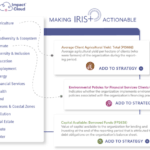Turning Cassava into Gold: Small Producer Taps into Big Demand in Kenya
When 26-year-old Elizabeth Gikebe sees cassava, she doesn’t see what most people see – an orphaned crop for rural, poor African farmers. She sees gold.
As the founder and managing director of Mhogo Foods, this career software developer has found a niche processing cassava into gluten-free flour, starch and animal feed, and sees a bright future for Kenyan cassava farmers and processors like herself.
Cassava flour – unlike wheat, barley and rye flours – is gluten free. According to studies by the American College of Allergy, Asthma and Immunology (ACAAI), when someone with celiac disease consumes gluten, it can damage their small intestines. Cassava flour is also suited for people with wheat allergies like hay fever, according to ACAAI. So it can be a one-to-one replacement for wheat flour.
As urban Kenyans become health conscious in their diets, demand in mainstream supermarkets for traditional foods like cassava has increased. Since Mhogo Foods began operations in July this year, uptake of the company’s signature cassava flour in local shopping and beverage outlets has been encouraging. “So far we have 34 supermarkets we are supplying our flour to,” said Gikebe, and that includes one of the top supermarket chains in Kenya.
Mhogo also supplies Kaldis Coffee House, where the flour is used in baking. The flour has a six-month shelf life and can be used to make bread, pancakes, cassava ugali, brownies, cookies and more.
Through Farm Concern International, Gikebe has gained access to about 40 farmers from the Busia, Makueni and Embu regions. Each month, these farmers supply Mhogo Foods with 30 to 40 tons of raw, dried cassava. The dried cassava is processed into 20 to 30 tons of flour and distributed to shopping outlets in Thika, Nanyuki, Gilgil and Kiambu, and other regions on demand. Having started operations with capital of 800,000 Kenyan shillings (about $7,830 in U.S. dollars), Mhogo Foods has a monthly turnover of about Ksh 300,000 ($2,936).
The company has seven full-time employees; four are in the sales department, the rest in production. Two salespeople are in Mombasa and two in Nairobi. Gikebe has also harnessed social media to popularize the flour and reach more customers. The Mhogo Foods Facebook page has more than 13,000 likes, and facilitates quick interactions between the company and customers needing cassava flour deliveries within Kenya. “We even get enquiries from as far as Australia for our flour,” she said.
Gikebe caught the bug of food processing at an early age, as her parents ran a milling business. But her passion gradually focused more on roots and tubers processing. To learn how to process cassava, she enrolled for a one-month course at the Kenya Industrial Research and Development Institute. That equipped her with knowledge on cassava plant-based value addition. She plans to start processing flour from other traditional roots and tubers soon.
Even with the strides Mhogo Foods has made, there have been challenges. According to Gikebe, most of the top Kenyan supermarkets with a wider reach and customer base view Mhogo Foods as a “small” company, even though they can supply 5 tons of cassava flour daily, given the opportunity. “That makes it hard to reach potential customers around the country,” she said. There is also the challenge of funds, to hire more salespeople to market the cassava flour.
Both maize and cassava are staples for more than 550 million Africans, according to the African Agricultural Technology Foundation. The typical yields for white maize in the main producing countries in the eastern and southern regions of Africa range from 1.1 to 1.8 tons per hectare, according to the Food and Agriculture Organization (FAO). Meanwhile, in a country like Nigeria, where cassava farming is predominant, a hectare produces on average about 10 tons. Cassava matures for harvest in six months while maize takes around four months, but in the long run, cassava farmers have more to eat than maize farmers, who harvest sooner. Cassava, unlike maize, is highly drought tolerant and can grow in semi-arid areas with little rain.
According to 2014 data by FAO, Kenya’s annual cassava fresh root production is estimated at 662,405 tons, against an estimated annual demand of 301,200 tons of dried cassava and 1,204,800 metric tons of fresh roots (one ton of cassava flour is obtained from four tons of fresh cassava roots). That demand gap is what Gikebe is keen to exploit to the benefit of smallholder cassava farmers in the country.
“Cassava is a drought-resistant crop not very hard to care for in the farm, but in Kenya people are dying of hunger due to overreliance on maize as a staple. That is why I process it,” she said.
James Karuga is a freelance print and video journalist from Nairobi, Kenya.
Photo: Elizabeth Gikebe with some of her cassava flour. By James Karuga
- Categories
- Agriculture



